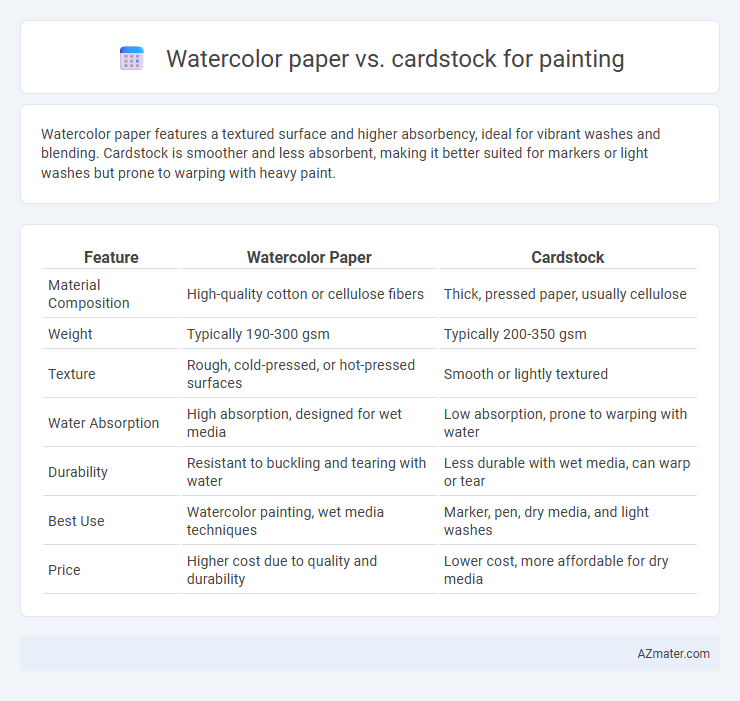Watercolor paper features a textured surface and higher absorbency, ideal for vibrant washes and blending. Cardstock is smoother and less absorbent, making it better suited for markers or light washes but prone to warping with heavy paint.
Table of Comparison
| Feature | Watercolor Paper | Cardstock |
|---|---|---|
| Material Composition | High-quality cotton or cellulose fibers | Thick, pressed paper, usually cellulose |
| Weight | Typically 190-300 gsm | Typically 200-350 gsm |
| Texture | Rough, cold-pressed, or hot-pressed surfaces | Smooth or lightly textured |
| Water Absorption | High absorption, designed for wet media | Low absorption, prone to warping with water |
| Durability | Resistant to buckling and tearing with water | Less durable with wet media, can warp or tear |
| Best Use | Watercolor painting, wet media techniques | Marker, pen, dry media, and light washes |
| Price | Higher cost due to quality and durability | Lower cost, more affordable for dry media |
Understanding Watercolor Paper: Key Features
Watercolor paper is specifically designed to handle heavy water application without warping, featuring a textured surface that enhances pigment absorption and color blending. Typically made from 100% cotton or cellulose fibers, it offers durability, strength, and excellent archival quality, ensuring the artwork remains vibrant over time. Unlike cardstock, watercolor paper's thickness and absorbency prevent bleeding and enable detailed layering techniques essential for watercolor painting.
What is Cardstock? Properties and Uses
Cardstock is a thick, durable paper known for its stiff texture and smooth surface, making it ideal for various crafting and artistic applications. Unlike watercolor paper, which is designed to absorb moisture and prevent warping, cardstock is less absorbent and works best with dry media or light washes. Its versatility makes it popular for greeting cards, scrapbooking, and mixed media projects where a sturdy base is essential.
Texture and Tooth: Comparing Surfaces
Watercolor paper features a pronounced texture and strong tooth, designed to absorb water and pigment evenly, enhancing color vibrancy and detail retention in paintings. Cardstock typically has a smoother surface with minimal tooth, making it less effective for water-based media but suitable for dry media or light washes. Artists seeking durability and rich texture benefit from watercolor paper's porous and fibrous quality, while cardstock excels in projects requiring a firmer, less absorbent surface.
Absorbency and Paint Handling Differences
Watercolor paper features high absorbency with a textured surface designed to hold water and pigments, enabling smooth blending and preventing paint from pooling. Cardstock, with its denser, less porous fiber composition, absorbs paint poorly, causing colors to sit on the surface and often resulting in uneven drying or buckling. Artists seeking precise control over washes and layering typically prefer watercolor paper, while cardstock is better suited for dry media or light washes where less absorbency is needed.
Durability and Longevity in Artwork
Watercolor paper offers superior durability and longevity for painting due to its thicker, more absorbent fibers that resist warping and deterioration over time. Cardstock, typically thinner and less porous, lacks the resilience needed to withstand heavy washes and prolonged moisture exposure, leading to potential buckling and fading. For artists prioritizing archival quality and preservation, high-quality watercolor paper ensures artwork maintains vibrancy and structural integrity for decades.
Color Vibrancy and Finish Results
Watercolor paper boasts superior color vibrancy due to its high absorbency, allowing pigments to blend seamlessly and produce rich, luminous hues. In contrast, cardstock's smoother surface limits pigment absorption, often resulting in flatter, less dynamic colors and a glossier or matte finish that can diminish depth. The textured surface of watercolor paper enhances paint flow and finish, making it ideal for detailed and layered painting techniques.
Suitability for Wet Techniques and Layering
Watercolor paper is specifically designed to handle wet techniques, featuring high absorbency and a textured surface that prevents buckling while allowing pigments to blend smoothly. Cardstock, while sturdy, lacks the necessary absorbency and texture, often resulting in warping and uneven pigment distribution when exposed to water. For layering, watercolor paper supports multiple washes and reworking without degradation, whereas cardstock may deteriorate or peel, making it less suitable for advanced wet painting methods.
Cost and Availability Considerations
Watercolor paper generally costs more than cardstock due to its specialized fibers and texture designed to absorb water and prevent warping, making it ideal for painting. Cardstock is more affordable and widely available at most craft stores, but it lacks the durability and absorbency required for water-based mediums, often causing paint to pool or bleed. Artists prioritizing budget and accessibility might start with cardstock, but those seeking professional results typically invest in higher-quality watercolor paper despite the higher price.
Best Projects for Watercolor Paper vs Cardstock
Watercolor paper is ideal for projects requiring heavy paint application, wet washes, and blending techniques due to its high absorbency and textured surface, making it the best choice for fine art paintings and detailed landscapes. Cardstock, with its smooth surface and lower weight, suits dry mediums and light watercolor washes, perfect for crafts, greeting cards, and mixed media projects where minimal warping is desired. Choosing between watercolor paper and cardstock depends on the intensity of water use and the desired texture, with watercolor paper supporting professional-grade artworks and cardstock excelling in lightweight and decorative crafts.
Choosing the Right Surface for Your Artistic Goals
Watercolor paper offers superior absorbency and texture, making it ideal for fluid washes and detailed wet-on-wet techniques, while cardstock provides a smoother, less absorbent surface better suited for dry media or light washes. Artists aiming for vibrant, layered watercolor effects benefit from heavier, cold-pressed or rough watercolor paper, typically ranging from 140 to 300 lbs, whereas illustrators or crafters working with mixed media might prefer the sturdiness and versatility of cardstock. Selecting the right surface depends on the intended painting style, medium, and desired durability, ensuring optimal paint application and longevity of the artwork.

Infographic: Watercolor paper vs Cardstock for Painting
 azmater.com
azmater.com